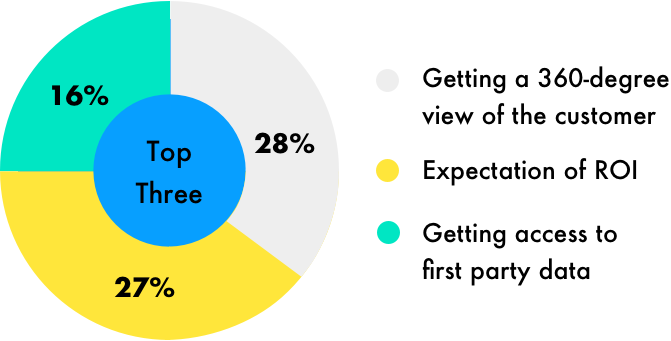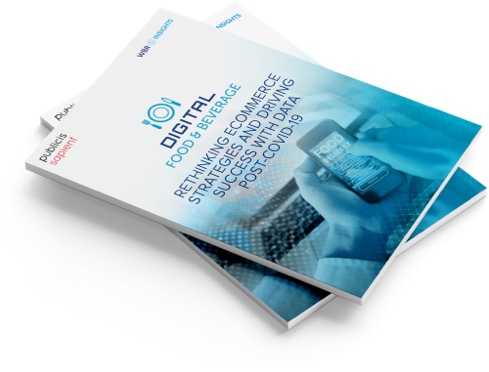What issue can we solve for you?
Type in your prompt above or try one of these suggestions
Suggested Prompt



Consumer Products
100 Food and Beverage Executives on Data Strategy
100 Food and Beverage Executives on Data Strategy
How to turn data into a strategic advantage: start with the customer
We partnered with WBR Insights to survey Food & Beverage marketing
executives across Europe on their data opportunities, challenges and plans.
Unsurprisingly, they told us that getting a 360-degree view of the customer is their
No. 1 challenge in using data to drive profitable business decisions.
What are the primary challenges your company faces in using data to drive profitable business decisions?

Findings like these are paired with insights and inspiration from across the sector for
a report that makes data-driven Food & Beverage strategies both actionable and
accessible. Read on for an excerpt from our own Scott Clarke, and click below access
the full report.

Digital Benchmark Report
Read “Rethinking Ecommerce Strategies
and Driving Success with Data Post-
Covid-19” for valuable findings and
actionable insights.
How food and beverage brands are turning data into a strategic advantage
By Scott Clarke, Vice President, Consumer Products
Industry Lead, Publicis Sapient.
The global pandemic has highlighted the vital role data, artificial intelligence (AI) and advanced analytics can play in the day-to-day business processes and decision-making of the modern enterprise. The rapid rate of technological change, growing levels of connectivity between individuals, businesses and smart devices and increasing volatility in the marketplace all combine to favour the increased use of non-human systems by consumer packaged goods (CPG) companies to identify and exploit insight-driven opportunities.
Enabling trends such as cloud computing, 5G networks, the internet of things (IoT), adaptive data platforms and the growing acceptance of technology-based solutions are poised to accelerate the wide-scale adoption of data-driven decisionmaking while providing the infrastructure to support data collection and advanced analysis on a hitherto impossible scale.
Food and beverage brands are not oblivious to the importance of data analytics as a source of strategic advantage. For a large number of food and beverage brands, the quest for first-party data and the pivot to data-driven decision-making were key business imperatives long before the pandemic hit. As we look to the post-pandemic world, food and beverage brands identify data analytics/data science as a primary FY21 investment, second only to direct-to-consumer (DTC) business models and platforms (Digital Food and Beverage Benchmark Report, 2021).
With greater pressure on businesses to operate quickly and with certainty, these brands will need to find ways to systematically harvest and integrate structured and unstructured data across multiple, eclectic sources and then turn this data into valuable and actionable insights with speed and scale.
Today, the data-driven use cases most frequently adopted by food and beverage brands include the use of AI to analyse product and/or consumer data, the use of advanced analytics to predict consumer demand, and the application of natural language processing (NLP) to generate insight from customer service data (Digital Food and Beverage Benchmark Report, 2021).
As we look to the future, as artificial intelligence becomes more accessible and affordable, it would be reasonable to anticipate the widespread application of artificial intelligence and machine learning (ML) to greatly enhance the brand’s ability to predict and respond to consumer demand patterns and preferences in real-time. In the not-too-distant future, these predictive algorithms will be combined with a back-end decision-management capability to effectively automate the mass volume of decisions that brands will need to make each day related to the consumer and the business as a whole.
Looking forward, as voice-assistants and chatbots continue to rise in prominence across the shopping journey, expect to see increased investments in natural language processing and voice biometrics to create more personalised end-to-end experiences through these channels. Moreover, as brand engagement expands into emerging channels such as smart cars, smart appliances and smart TVs, it will be a safe bet to assume that AI and ML will become a major investment focus to unleash the intimate power of these channels as well.
For the majority of food and beverage brands the pivot to datadriven decision-making is not without its challenges, ranging from inherent difficulties in developing a 360-degree view of the consumer, to demonstrating the ROI on data investments, to trusting in the quality of the data captured (Digital Food and Beverage Benchmark Report, 2021).
Successful brands tend to follow a series of systematic steps in overcoming these challenges and in turning data-driven decision-making into a core business capability. It begins with developing an overall data strategy that focuses the attention on the things that have a real business value.
The questions that need to be addressed are not “how do I get more meaning from this data or that data” but rather, “how can I acquire and retain consumers better”; “how can I drive consumers loyalty”; “how can I predict what consumers might buy”, etc. Once the key questions and use cases are identified then the brand must determine what data it needs and when to be able to answer these questions in an informed and reliable way.
It must then determine from where this data is best sourced and define the optimal processes and technology ecosystem to enable the capture, integration and activation of this data in a way that unlocks its maximum potential and drives the desired business benefit at the right time and place.
“Specifically for food and beverage brands, they have a challenge in constructing 360-degree views of their customers. Rather than trying to gather everything about a customer, a more prudent approach is to identify what is important to the process of servicing customers and giving them value, and focus on that data only. The world is full of over-specified and underused customer 360s.”
Simon James , International Lead Data & AI







